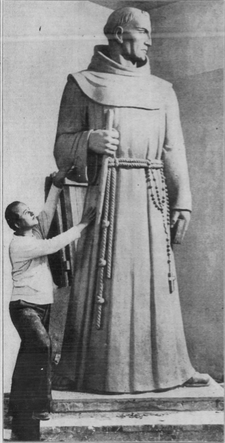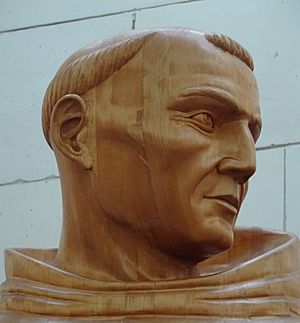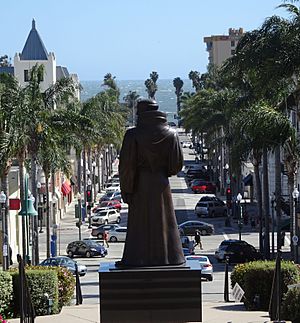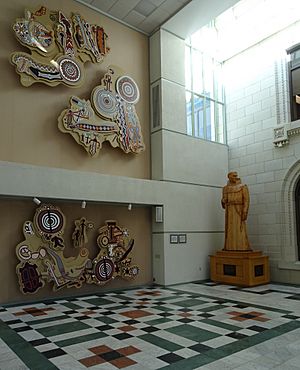Father Serra statue facts for kids
Quick facts for kids Father Serra statue |
|
|---|---|
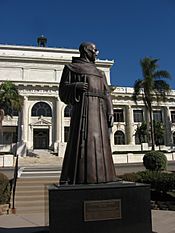
Bronze cast in front of Ventura City Hall in 2009
|
|
| Artist | Uno John Palo Kangas |
| Year | 1936 |
| Medium | Clay, concrete, wood, and bronze |
| Location | originally in front of Ventura County Courthouse, no longer on public display, Ventura, California |
| 34°16′55″N 119°17′35″W / 34.28198°N 119.29310°W | |
The Father Serra statue in Ventura, California, shows Junípero Serra. He was a Spanish priest who started Mission San Buenaventura. The statue was ordered by Ventura County in 1935. It was part of a government program called the Works Progress Administration (WPA) and its Federal Art Project.
The artist, Uno John Palo Kangas, sculpted the statue. It was placed in a public park near the Ventura County Courthouse in 1936. Later, the courthouse became Ventura City Hall. In 1974, the concrete statue was named a City of Ventura Historic Landmark.
The statue is nine feet, four inches tall. It shows Father Serra standing, looking left. He wears a Franciscan robe with a hood and sandals. A rope belt with a rosary hangs from it. He holds a book in his left hand and a walking stick in his right.
Over time, the concrete statue started to wear out. A wooden copy was made by local carvers. This wooden copy was then used to create a bronze statue. The bronze statue replaced the concrete one in 1989. The wooden copy was placed inside the city hall for people to see.
However, displaying statues of Junípero Serra has caused arguments. Some people believe Serra was unfair to the Chumash people and their culture. In 2020, the city council decided to remove both the bronze statue and the wooden copy from public view.
Contents
History of the Statue
In 1935, Uno John Palo Kangas (1904–1957) was chosen to create the Father Serra statue. Kangas was a sculptor from Finland who grew up in Michigan. He was paid $5,000 for his work. This project was part of the Federal Art Project, a program by the Works Progress Administration (WPA). The WPA was a government effort during the Great Depression to create jobs.
Making the Clay Sculpture
Kangas prepared by visiting missions in Santa Barbara and Ventura. He studied pictures of Serra and learned about his life and clothes. He also drew many sketches.
The first step was making a full-size clay model. This clay model took four months to finish. Kangas built it in his Los Angeles studio. He used a frame of wood and chicken wire, then covered it with layers of clay. A person who knew the artist said Kangas used a local man, Gordon Douglas, as a model for Serra's face. In 1936, the Los Angeles Times newspaper showed a large photo of Kangas with his clay sculpture.
No one knows what happened to the original clay sculpture. A newspaper story from 1938 suggested it might have been shown at a museum in Butte, Montana.
The Concrete Statue
Next, Kangas made a mold of the clay sculpture using plaster. This mold was set up outside the courthouse. He built a frame around it. Kangas collected sand and gravel from the Ventura River. He mixed these to make a concrete material. He then poured the concrete into the mold right there. After the concrete became hard, the mold was taken off. Kangas then smoothed the outside of the statue.
On November 27, 1936, the concrete statue was revealed. It was placed in a public park across from the Ventura County Courthouse. Many important people attended, including Governor Frank Merriam. Governor Merriam said the statue showed Serra as "noble, brave and holy." Later, the courthouse became Ventura City Hall. The park and the concrete statue became part of the city hall property. In 1974, the concrete Father Serra statue was named a historic landmark.
By the 1980s, the statue was damaged. Years of salty air from the ocean and rainwater collecting in its robe caused problems. Also, the statue was painted by vandals. When the city cleaned it with sandblasting, it damaged the smooth surface even more. In September 1989, the concrete statue was taken down. The city planned to store it for a future museum. However, in 1996, a reporter found the concrete statue in a scrap yard. As of 2018, it was still there, in a decaying wooden box.
The Wooden Copy
In 1971, the concrete statue became the property of the City of Ventura. By 1983, a city council member, Russell Burns, reported that the statue was falling apart. The city then hired experts to study the statue in 1984. They all agreed the statue was too fragile to be copied directly. They said it should be moved indoors.
Councilman Burns suggested making a wooden copy of the statue. This wooden copy could then be used to create a bronze statue. The bronze one would replace the old concrete statue. In 1986, the Ventura City Council agreed to this idea. The city provided some money to start the project. Local supporters raised over $100,000 by selling small bronze copies, posters, and "I Support the Serra Statue" items.
The process of making the wooden copy was very detailed. They took 1,782 exact measurements of the concrete statue. Over 4,000 charts, drawings, and photos were made from these measurements. Master carver Wilbur Rubottom and 16 other carvers worked on the wooden copy. They worked in a studio in Ventura. They started with large pieces of basswood from linden trees. These pieces were glued together to form a 1,200-pound block.
The carvers' studio was open to the public. Schoolchildren, older people, and tourists visited to watch them work. During the 1987 Ventura County Fair, the wooden block was moved there. The carvers' work became a popular attraction. The carving took 14 months, from April 1987 to June 1988. In total, 10,000 hours of work went into creating the wooden copy. The wooden copy was placed in the atrium of Ventura City Hall on October 7, 1988.
The Bronze Statue
In 1988, the City of Ventura hired student artists from the California Sculpture Center. They were to create a bronze statue using the wooden copy. The students visited the wooden statue and made latex molds in many parts. The bronze figure was then cast in 20 pieces. They used a method called "lost wax" casting.
The bronze statue was revealed on October 20, 1989. More than 500 people attended the ceremony in front of Ventura City Hall. The bronze statue stands on a concrete base. This base is covered with shiny black granite from the Andes Mountains.
The bronze statue replaced the original concrete one in 1989. It stands in the small park overlooking downtown Ventura and the Pacific Ocean. A plaque at the base thanks the people who helped replace the old statue.
Reactions and Removal
The city's plan to display the wooden copy inside Ventura City Hall faced problems. The city art committee thought it was too big for the atrium. Also, the Candelaria American Indian Council objected. They felt that Father Serra had treated the Chumash people unfairly. Jessica M. Roybal, from the Indian Council, said it was "a slap in the face to the Indian people." The wooden statue was placed in a corner of the atrium with signs explaining its history.
The statues also faced vandalism. In 1980, paint was poured on the concrete statue. In 1991, paint was thrown at the bronze statue. Words like "Spirit of Crazy Horse" and a clenched fist were spray-painted nearby. In 1992, the bronze statue's hand was painted red. A message accused Serra of being a symbol of slavery for Native Americans.
In 2015, Pope Francis made Serra a saint. This brought more attention to the Ventura statue. In 2017, an article in the Ventura County Star called for the statue's removal. The author said such statues were "a direct slap in the face of all Chumash and other Native American cultures."
In June 2020, there was a national discussion about removing certain statues. The mayor of Ventura, the pastor of Mission San Buenaventura, and the tribal chair of the Barbareño/Venureño Band of Mission Indians agreed to take down the statue. They wanted to move it to a private place. The tribal chair, Julie Tumait-Stenslie, said that Serra protected Native Americans because they were "the free labor force, the slave labor for the missions." The city council voted to remove the statue in July.
On July 24, construction workers removed the bronze statue from its base.
Wider Protests Against Serra Statues
Junípero Serra was a Roman Catholic Spanish priest and friar. He founded nine Spanish missions in California. In 1782, he founded Mission San Buenaventura, his last mission, in what is now downtown Ventura.
Many people object to public statues of Serra. They point to the mistreatment of Native American people during the mission era. After Serra became a saint in 2015, several of his statues were vandalized:
- At Carmel Mission, a statue was covered in green paint. "Saint of Genocide" was written on a nearby stone.
- In Monterey, a statue's head was removed.
- At San Fernando Mission, a statue's hands were painted red. The word "murderer" was written on it.
- At Mission Santa Barbara, a statue's head was removed and it was covered in red paint.
- At San Gabriel Mission, a statue was cut with a saw and splashed with red paint.
The discussion and damage to Junípero Serra statues grew during the George Floyd protests. These protests also focused on monuments of people linked to the historical mistreatment of indigenous peoples in the Americas.
- A statue in Los Angeles was pulled down.
- Another statue in San Francisco was also toppled.
- A statue in Carmel was removed for safekeeping.
- The Mission San Luis Obispo de Tolosa also took down their statue from public display.


